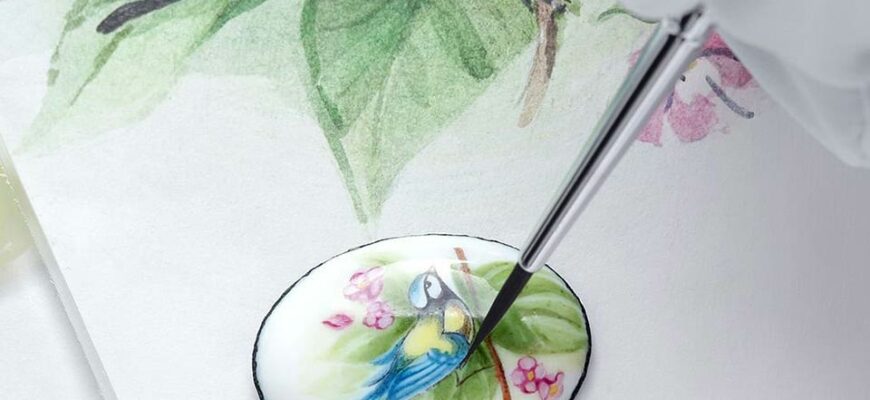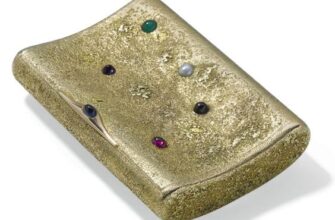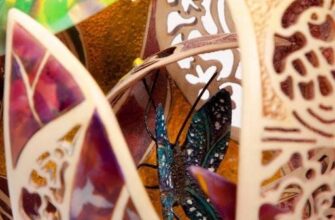What is finift? This is a kind of applied art in which the production of works of art is carried out using vitreous powder, enamel and a metal substrate. Enamel acquires the desired color after the firing procedure with the help of additives for which metal salts are used. For example, gold additives give glass a ruby color, cobalt is known for blue, and copper is known for green.
You, most likely, have seen these jewelry in your grandmother's jewelry box more than once. It is impossible not to pay attention to such products, as they are different from all the others. But, unfortunately, rare people wear enamel in the modern world, it is not as fashionable as it was 50 years ago. If you are a true connoisseur of beauty or just a curious person with taste, then we recommend that you learn a little about fine jewelry with enamel.
Where and how did enamel originate?
The art of enamel and enamel jewelry originated several thousand years ago in the East. This method became known by accident, as a side discovery during the melting of glass.
When did finift appear? Enamel came from Byzantium in the XNUMXth century, where it was called "fire writing". Russian jewelers mastered the new technique and began to decorate icons, church utensils and religious books with it. Later, Moscow craftsmen decorated small household items with enamels: figurines and caskets, pens and inkwells, watches, snuff boxes and cutlery.
Sometimes earlier people believed that enamel was made from molten precious stones, it was so beautiful and bright.
In the XNUMXth century, the history of enamel was continued by the French jeweler Jean Tutin, who discovered the secret of translucent refractory paints.
The heyday of enamel occurred in the XNUMXth-XNUMXth centuries, at the same time the main genres of colored enamel were formed: masters depicted fairy-tale and historical plots, landscapes and Orthodox churches on decorative objects. And on jewelry - floral ornaments. For a long time, the church remained the main customer: durable, bright and elegant miniatures adorned icon frames and clothes of clergymen, and pilgrims took small enamel images of saints with them from the monasteries as a keepsake.
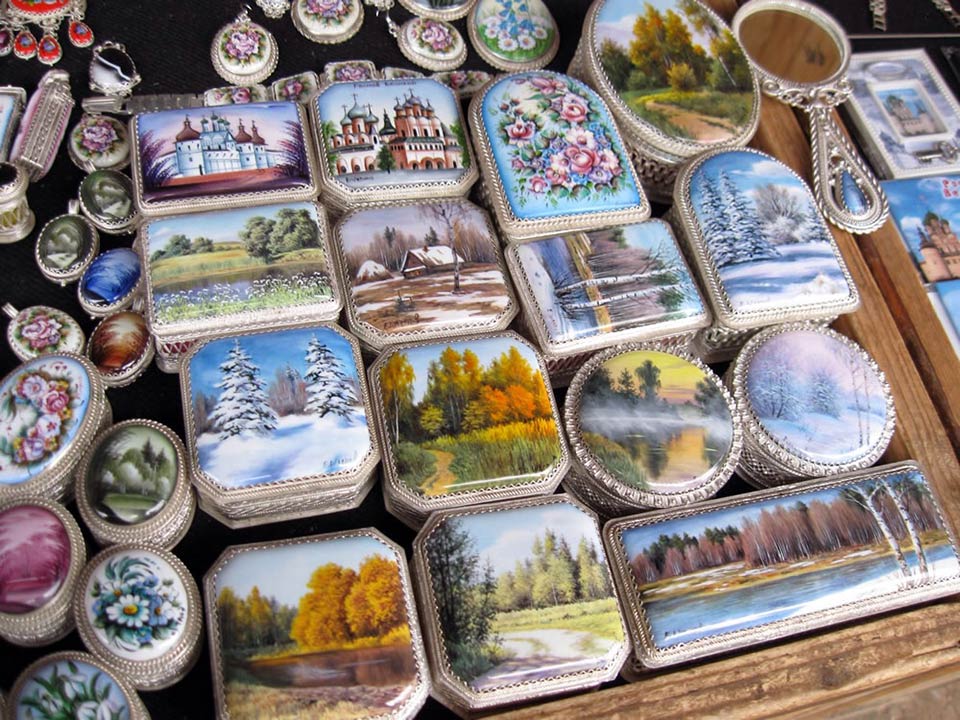
In the XNUMXth century, Russian enamel became known all over the world., art developed, miniatures on enamel were valued on a par with precious stones. Fishing flourished in Nizhny Novgorod, Kostroma and Uglich. The scientist Mikhail Lomonosov contributed to the development of the enamel business: on his initiative, a glass-making factory was built, glass was used as the basis for paints. At the Academy of Arts in St. Petersburg, a class "painting on enamel" was founded, in which future artists studied.
In Ancient Russia, enamel was an indicator of wealth, luxury and prosperity. Not many families could afford such decorations and religious objects.
In many ways, the direction of art has become popular thanks to mastery of enamellers from Rostov the Great, the spiritual center of the country. Pilgrims from distant corners came to Rostov's ancient churches and monasteries, each of them wanted to take a memorabilia with them. Small and bright enamel icons, in contrast to images made of precious metals, were inexpensive and were sold in large quantities in church shops.
Rostov has long been famous for its icon painters, the first workshops of enamellers appeared in the city in the 1760s. Then workshops were opened where artisans worked on church orders: in heavy and hazardous production, enamel was melted in furnaces, lead was added to paints to lower the melting point. Over time, Rostov began to supply monasteries throughout the country with enamel, bright icons were in demand among the people. At the same time, “secular” enamel was also developing, craftsmen made trays and dishes, decorated cutlery. Wealthy ladies wore bracelets and rings with enamels instead of precious stones, men bought watches, pipes and snuffboxes decorated with enamel.
In the 19th century, the main goods of Rostov enamellers were amulets and icons with the faces of saints, as well as caskets with city and monastery views.
By the beginning of the 20th century, Rostov enamel was in less and less demand. New technologies for stamping and printing made the production of enamels economically unprofitable, the craftsmen were forced to make hundreds of small samples per day. Artists painted icons and inserts for decorative items according to a template, the artistic side faded into the background.
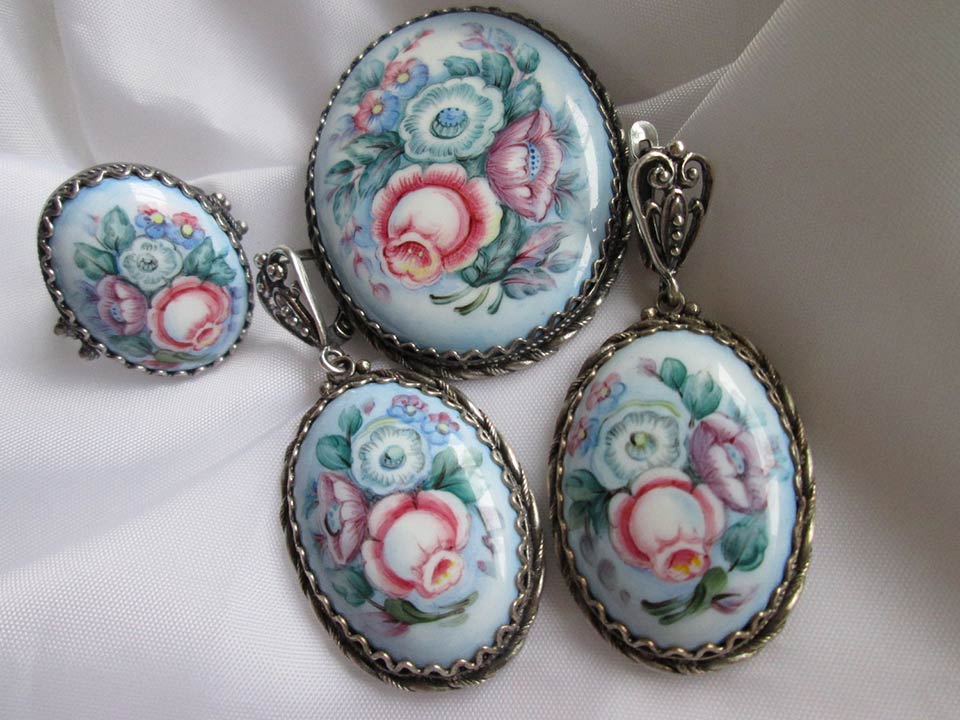
Finift technique: how and from what is enamel made?
Enamel is a vitreous mass (enamel) welded onto a metal plate forged in a special way and painted with overglaze paints.
In the manufacturing process of enamel, there are three stages:
- production of metal plates and coating them with white enamel;
- painting itself with paints;
- jewelry frame.
Today recipes for making enamel slightly different from the old ones.. The base plate is cut out of a sheet of metal. Use copper, bronze, brass, silver or gold. Then it is given the desired shape, achieving a perfectly flat surface in order to “bring whiteness” - to apply a layer of ground glass powder to the metal. The workpiece is sent to the furnace, the output is a smooth white surface. The reverse side is also covered with a glass composition so that the plate does not deform during firing.
In this form, the workpiece gets to the artist. On the convex glass part, he depicts miniatures and ornaments with refractory paints from vitreous powder. The technique is similar to porcelain painting: the artist works with a small brush and stroke by stroke draws a picture. The master outlines the general plan of the image, sends the product to the oven, cools it, and then writes out fine details and adds new colors. Each coat of paint is hardened at a temperature of approx. 700…800 degrees. Typically, artists limit themselves to three firings, but some subjects require up to five approaches.
The manufacturing technology makes enamel exceptionally durable: for example, the earliest enamels found by archaeologists have retained their appearance after three millennia.
Finished enamel in jewelry production is inserted into a frame made of silver or other metal, if we talk about simple jewelry. Often the basis is filigree - a thin lace pattern made of wire. Enamel does not change color over the years, it is not afraid of humidity and high temperatures.
The only downside to this product is fragility. Large jewelry needs to be handled with care, although small items remain quite durable and can easily withstand impacts. Precious stones can scratch the enamel layer, so enamel is stored separately from other jewelry.

Types of enamel
Depending on the technique in art, enamel is made by resorting to various manufacturing methods.
painted. It is done with paints, which include essential oils. All parts of the design are applied by firing, corresponding to the melting temperature of the new color. The image of a painting is often covered with an additional layer of protection.
Cloisonne enamel. This technique consists in soldering a wire to a metal base, inside the cells of which enamel is attached. The cell size is determined based on the image. The former craftsmen made recesses at the base, and only then they soldered the wire, which improved the fastening properties. This secret was revealed by Byzantine artisans.
Experimenting with different enamel techniques, artists have the opportunity to play with colors and volumes.
champlevé enamel. Here, several methods of strengthening enamel are used simultaneously with the help of recesses. Recesses are made in various ways: carving, stamping, chasing, it all depends on the master's idea.
Enamel in scanned frames. This manufacturing technology resembles the previous one, only they use twisted wire called filigree as partitions. Since this technology was used only in Russia, this enamel is called Russian.
Embossed - This is a very complex manufacturing technology. Enamel in a liquid state is not retained on the reliefs during firing and flows into its lower parts or burns out. So it turns out a picture mixed from several colors. The technique is quite complex, time-consuming, amenable only to real masters.
Enamel with metal overlays. The technology of this technique lies in the fact that images cut out of metal or foil are inserted between the layers of enamel, which look like floating inside the glass.
As a basis for stained glass enamel a metal openwork mesh is used, its links are filled with enamel and fired. All this is done several times until all the voids are filled with enamel. This is a very complex and painstaking work that requires a high level of skill.
When coated guilloche enamel impose several layers of a transparent substance, as well as an engraved fondon. This coating was widespread in the jewelry art of France, in Russia it began to be used later, including Faberge.
Where is finift made now?
The most famous place for the production of products of this type is still the city of Rostov. There is a factory called Rostov Finift.
The work of modern Rostov masters develops in a variety of genre and stylistic directions:
- portrait miniature;
- historical miniature;
- military historical portrait;
- lyrical landscape;
- plot compositions;
- landscapes;
- flower paintings.
The high appreciation of the artists' work is expressed in the awarding of the titles of laureates of the State Prize of Russia named after V.I. I.E. Repin.
The works of old and modern Rostov masters are kept in the State Historical Museum, the State Russian Museum, the State Hermitage, the Armory of the Moscow Kremlin, the State Museum-Reserve "Rostov Kremlin" and other museum collections and private collections in Russia and the world.
The Rostov Finift brand is known all over the world, and for more than 100 years, the Rostov Finift factory has been preserving the technologies and traditions of this bright type of miniature painting.
Along with painted enamel, cloisonne enamel is used at the factory, which decorates and emphasizes filigree, giving the products completeness and brightness.
Where is enamel produced in addition to Russia? Mass production of these products is rare. Usually these are exclusive shops, which are known only in narrow circles. Works with the enamel technique can be found in Europe: Italy, Spain, France, England, but you have to ask around and look. Sometimes orders come from well-known jewelry houses, but usually these are single pieces of beauty, which then go to private collections.
Is it fashionable to wear products from enamel
Enamel in jewelry, such as it was in ancient times, is quite difficult to find today in the open sale if you have not made an individual order. But many works of art can be found at flea markets, exhibitions of old things, antiques gatherings. Some people even collect this beauty. However, not many people manage to find it in its entirety. The problem is mostly in the wrong storage. Today, the technique of cloisonne enamel is more popular.. It is found almost everywhere without exception.
Many ladies ask how and with what to wear jewelry with enamel? Enamel looks especially good on ladies aged and on women with magnificent forms. The decorations are all large and massive in themselves, they go to the “royal persons”, similar to the rulers. Thick blond braid, rosy cheeks, sparkling eyes...
But even if you have a square and cheekbones are visible, do not despair, elongated models will suit you. Earrings are quite difficult to pick up, given that almost all jewelry is sold through the network. Much easier to choose a brooch or ring, here it is much more difficult to miscalculate with a suitable form.
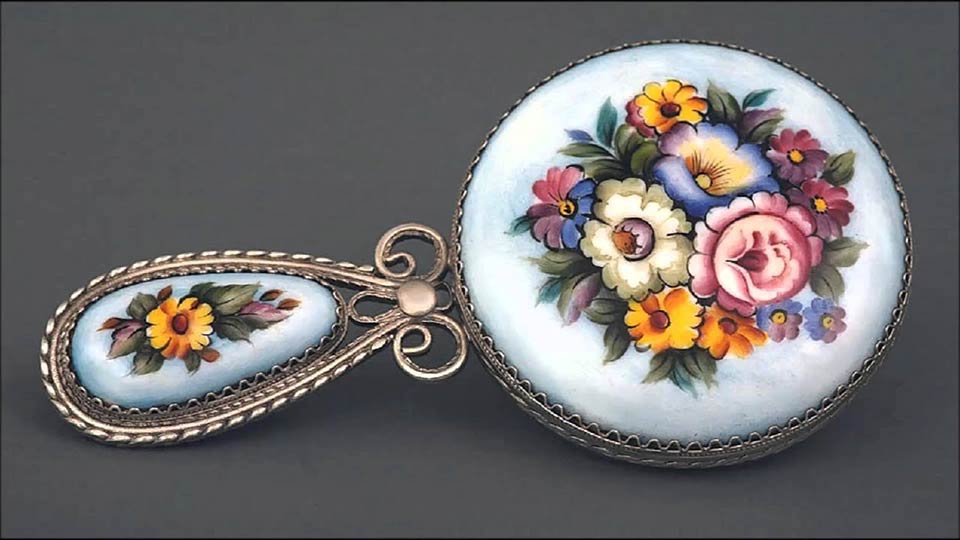
Enamel itself is not particularly popular now, but ardent fashionistas should have some models and colors. Earrings are best postponed until next season, as well as necklaces. Our massive neck ornaments are only good if they are monolithic, horseshoe-shaped.
If the want something on your neck, it is better to choose a pendant. The most popular pendant is a medallion with a painted lid or a flat oval pendant. It is preferable to choose floral motifs, pay special attention to peonies and roses. The background is preferably blue or beige.
Something, but enamel is definitely in trend vintage. It doesn’t matter if the decoration came from dispossessed relatives or Soviet grandmothers – everything is relevant. Enamel does not fade, but often has “burnt out” colors initially. The most vintage combination is cream, brown, sky blue and eggplant.
Modern decorations are no worse. The best modern works are made in the Gzhel technique. Modern models have bright and saturated colors, and they are the best fit for young ladies.
With what to wear
Since the jewelry is quite massive, wearing them to business meetings and work is quite problematic. The only thing that is appropriate in the workplace, and even then not always, is a brooch. It can be pinned to a jacket, cover buttons, or hold a handkerchief. It is worth choosing decoration for work in calm or dark tones.
The most popular among jewelry now enjoy brooches. They are suitable for any season. Enamel is especially good in spring, when you want bright colors and colors, ancient enamel - in autumn, and bright modern painting - in winter. In cold weather, it is recommended to attach the brooch to a coat or a tight jacket.
Brooches are usually massive, so they look best with tight clothes and various textures. Enamel on a brooch will be good on a thick sweater, vest, suit, coat, but not in combination with flowing translucent blouses. Remember.
For romantic "air" persons it will be difficult to choose the right option. Best with cute dresses and lace will look set of earrings and pendant with pink and blue flowers. If bright colors are your favorites, then take jewelry with sky blue and grass green painting.
We hope that it was interesting, and now your horizons have expanded a little. Of course, for a complete picture, it would be desirable to visit a couple of museums where you can find objects of enamel from antiquity. Believe me, this spectacle is impressive, it will not leave indifferent any person who at least a little soul is drawn to art.
